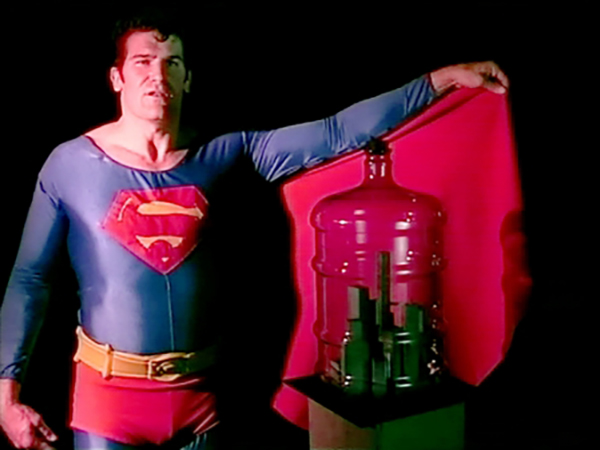2015 End of Year Review
What do the following buildings have in common?
SOURCE: BLiNK - Perspectives on Design - Read entire story here.
What do the following buildings have in common?
SOURCE: BLiNK - Perspectives on Design - Read entire story here.
Nearing the fourth anniversary of Mike Kelley’s death, REDCAT presented a theatrical screening of six of his video works, curated by Steve Anker and Bérénice Reynaud as part of the Jack H. Skirball Series. The selection of works in Mike Kelley: Single Channel Videos included a one-act melodrama based on a black-and-white yearbook photograph, a hammy and melancholic Superman reciting Sylvia Plath, an invocation of power through juvenile imagination, and collaborations with Paul McCarthy and BDSM dyad Sheree Rose and Bob Flanagan.

Mike Kelley. Superman Recites Selections from ‘The Bell Jar’ and Other Works by Sylvia Plath, 1999 (film still); 7:19. Art © Mike Kelley Foundation for the Arts. All Rights Reserved/Licensed by VAGA, New York, NY.
A little over a year ago, MOCA curator Bennett Simpson arranged the Los Angeles iteration of Kelley’s posthumous retrospective, Mike Kelley, at the Geffen Contemporary. First organized by the Stedelijk Museum Amsterdam and curated by Ann Goldstein, the exhibition included a number of Kelley’s major installations. There, his video works were part and parcel of a larger whole, submerged into hilarious, exploded altars to the American ritual. In its entirety, the exhibition was loud, stimulating, and messy—and rightly so. Like Frankenstein’s monster, Mike Kelley was a chaotic assemblage whose sensitive eloquence gained psychic strength from the dissolution of the singular, rather than a distillation toward the sublime. There is no way to neatly separate and isolate light and sound within the box of a building that is the Geffen, and there is no reason to pursue that kind of purity with Kelley’s artworks, which are so much about the uncanny—how near-familiar images and objects can push their fingers into our psyche, beyond the clean boundaries of conscious control.
Nonetheless, at REDCAT’s presentation on December 14, 2015, curator Bérénice Reynaud framed the screening as arising out of Kelley’s MOCA retrospective, her idea being that the video works necessitated a theatrical screening so that they could be experienced in a facility specifically built for viewing films. As promised, REDCAT provided a space that enhanced the innate qualities of the medium, which in effect changed the experience of the six presented video works in varying ways. In the organized darkness of the theater, I could see the moving image projected in front of me, but I couldn’t see my hands. The sweet boozy scent of my neighbors became all the more palpable. The theatrical seating and its positioning of bodies created a sort of nonconfrontational, gentle sense of community—one unified by a common focus and consolidated by sharing a point of reception and reaction in space and time.

Mike Kelley. Extracurricular Activity Projective Reconstruction #1 (Domestic Scene), 2000 (film still); black and white; 29:44. Art © Mike Kelley Foundation for the Arts. All Rights Reserved/Licensed by VAGA, New York, NY.
In this way, I enjoyed the strange intimacy of knowing the range of laughter that Kelley’s 100 Reasons (1991) elicited from my tipsy, unseen companions. My happy, drunken neighbors were brought to a new height of hilarity each time Kelley’s voice read aloud another one of the hundred names for a spanking paddle, while Mistress Rose swung her paddle, slapping Bob Flanagan’s ass and swelling his flesh into a plum hue. By the time Kelley read “board of education,” I was tearing from laughter, too.
The histrionic dialogue and melodramatic framing of Extracurricular Activity Projective Reconstruction #1 (Domestic Scene) (2000) brought out a similar set of communal responses. Laughter bubbled up throughout the exaggerated overtures of the simplified, dramatized dynamics of two figures whose relationship is marred by oppositional forces—desire and guilt, empathy and torture, acceptance and repression, among others—in the nearly thirty-minute act. Laughter stopped in a caesura of seriousness when the two actors looked toward death—an open oven with a tiny dancing ghost of Sylvia Plath inside—until the dialogue broke through the veil of austerity with a sharp return and reminder of the overplayed power dynamic of sexual dominance and submission. After a descent into a romanticized narrative of suicide, the submissive character is reminded that even though he may be Sylvia Plath’s in death, his ass is still his partner’s in life; at that moment, laughter burst out in the theater.
Likewise, in Bridge Visitor (Legend–Trip) (2004), the juvenile incantations of power in projections of the satanic touched upon childlike ideations of the occult. The resurgence of faith in the unknown exploded when the audience realized the orb of bubbling liquid in the video was a skillfully shot point-of-view take of the speaking figure pissing into a toilet, prompting the theater to burst out laughing once again.
With the freedom to move at one’s own pace, walking through an exhibition is a much more isolated experience than sitting in a theater. Though the body’s individual relationship to the chaos and scale of objects was heightened in other presentations of Mike Kelley’s work, REDCAT’s theatrical screening of his video work opened up another kind of productive confusion in being a part of a collective audience, and in unraveling reactions in real time.
Editor’s Note: Special thanks to the Mike Kelley Foundation for the Arts.
Mike Kelley: Single Channel Videos was screened at REDCAT in Los Angeles on December 14, 2015.
SOURCE: DAILY SERVING - Read entire story here.
Read More
smart clothing that tracks muscle effort, providing actionable insight on your mobile device.
The post athos smart performance workout gear analyzes biometrics in real-time appeared first on designboom | architecture & design magazine.
SOURCE: designboom | architecture & design magazine - Read entire story here.
Read More